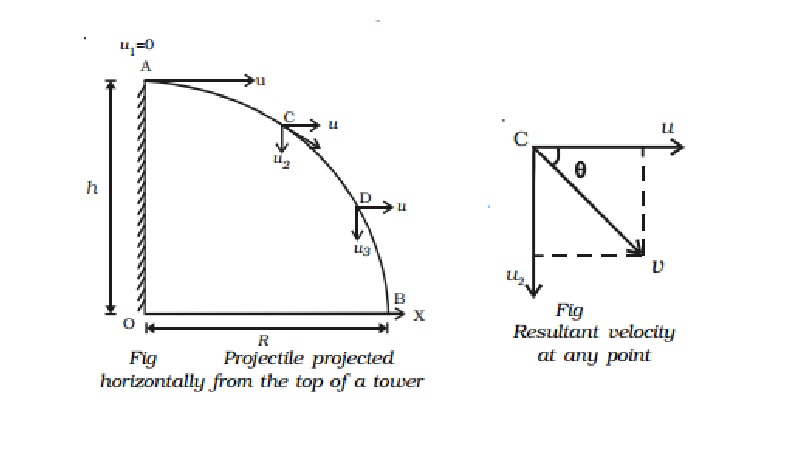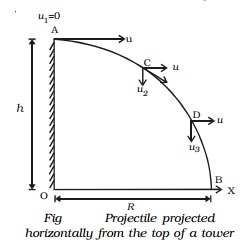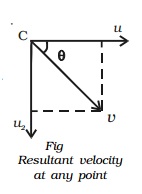Chapter: 11th 12th std standard Class Physics sciense Higher secondary school College Notes
Motion of a projectile thrown horizontally

Motion of a projectile thrown horizontally
Let us consider an object thrown horizontally with a velocity u from a point A, which is at a height h from the horizontal plane OX (Fig). The object acquires the following motions simultaneously :
(i) Uniform velocity with which it is projected in the horizontal direction OX
(ii) Vertical velocity, which is non-uniform due to acceleration due to gravity.

The two velocities are independent of each other. The horizontal velocity of the object shall remain constant as no acceleration is acting in the horizontal direction.
The velocity in the vertical direction shall go on changing because of acceleration due to gravity.
Path of a projectile
Let the time taken by the object to reach C from A = t Vertical distance travelled by the object in time t = s = y
From equation of motion, s = u1t + 1/2 at 2
Substituting the known values in equation (1),
y = (0) t + 1/2 gt 2 = 1/2 gt 2
At A, the initial velocity in the horizontal direction is u. Horizontal distance travelled by the object in time t is x. ???.(1)
x = horizontal velocity ? time = u t (or) t = x/u .........(3)
Substituting t in equation (2), y =1/2 g(x/u)2 = 1/2 g(x2/u2) ....(4)
(or) y = kx2 where k = 2/gu2 is a constant.
The above equation is the equation of a parabola. Thus the path taken by the projectile is a parabola.
Resultant velocity at C
At an instant of time t, let the body be at C.
At A, initial vertical velocity (u1) = 0
At C, the horizontal velocity (ux) = u
At C, the vertical velocity = u2

From equation of motion, u2 = u1 + g t
Substituting all the known values, u2 = 0 + g t
The resultant velocity at C is v = root[ux2+u22] = root[u2+g2t2] ..(6)
The direction of v is given by tanθ = v2/ux =gt/u ..(7)

where θ is the angle made by v with X axis.
Time of flight and range
The distance OB = R, is called as range of the projectile.
Range = horizontal velocity ? time taken to reach the ground
R = u tf ...(8)
where tf is the time of flight
At A, initial vertical velocity (u1) = 0
The vertical distance travelled by the object in time tf = sy = h
From the equations of motion Sy = ut t f + 1/2 g f f2...(9)
Substituting the known values in equation (9),
h = (0) tf = 1/2 g tf2
tf= root[2h/g] ...(10)
Substituting tf in equation (8), Range R = u . root[2h/g] ..(11)

Related Topics